Parametric Assessment of Seasonal Drought Risk to Crop Production in Bangladesh
Abstract
1. Introduction
2. Materials and Methods
2.1. Description of the Study Area
2.2. Data and Sources
2.3. Methodology
2.3.1. Sub-Systems of Hazard and Exposure
2.3.2. Classification of Indicators of Sub-Systems
2.3.3. Standardization of Data
2.3.4. Normalization of Indicators Using Catastrophe Models
2.3.5. Estimation of Drought Risk Index
- The drought risk to crops was considered as a product of drought hazard (severity and frequency) during a cropping season and exposure of crops to drought;
- The drought hazard and exposure were considered as two systems, each consisting of a number of sub-systems;
- The data of each sub-system were classified using a Jenks optimization algorithm to obtain the indicators of the sub-system;
- The mean of each indicator was standardized into a dimensionless number in the range of 0 to 1 which were considered as the rank;
- The catastrophe model was then used to estimate the normalized value of fuzzy membership function from the standardized values, which was considered as the weight of the sub-system;
- The drought hazard and exposure were estimated using Equations (6) and (7), respectively.where w refers to weight, r refers to rank, D10, D25, and D100 represent the return periods of 10-, 25-, and 100-year droughts, A refers to cultivated area, and Y represents crop yield.
3. Result and Discussion
3.1. Seasonal Drought Hazard
3.2. Drought Exposure
3.3. Drought Risk to Crop
4. Conclusions
Author Contributions
Funding
Acknowledgments
Conflicts of Interest
References
- Wang, X-J.; Zhang, J.-Y.; Shahid, S.; ElMahdi, A.; He, R.-M.; Zhen-xin, B.; Ali, M. Water resources management strategy for adaptation to droughts in China. Mitig. Adapt. Strat. Gl. 2012, 17, 923–937. [Google Scholar]
- Mohsenipour, M.; Shahid, S.; Chung, E.-S.; Wang, X.-J. Changing Pattern of Droughts during Cropping Seasons of Bangladesh. Water Resour. Manag. 2018, 32, 1555–1568. [Google Scholar] [CrossRef]
- Shiru, M.S.; Shahid, S.; Alias, N.; Chung, E.S. Trend analysis of droughts during crop growing seasons of Nigeria. Sustainability 2018, 10, 871. [Google Scholar] [CrossRef]
- Shahid, S.; Hazarika, M.K. Groundwater drought in the northwestern districts of Bangladesh. Water Resour. Manag. 2010, 24, 1989–2006. [Google Scholar] [CrossRef]
- Ahmed, K.; Shahid, S.; Harun, S.b.; Wang, X.-j. Characterization of seasonal droughts in Balochistan Province. Pakistan. Stoch. Environ. Res. Risk. Assess. 2016, 30, 747–762. [Google Scholar] [CrossRef]
- Alamgir, M.; Shahid, S.; Hazarika, M.K.; Nashrrullah, S.; Harun, S.B.; Shamsudin, S. Analysis of Meteorological Drought Pattern During Different Climatic and Cropping Seasons in Bangladesh. J. Am. Water. Resour. Assoc. 2015, 51, 794–806. [Google Scholar] [CrossRef]
- Sung, J.; Chung, E.S.; Shahid, S. Reliability–Resiliency–Vulnerability Approach for Drought Analysis in South Korea Using 28 GCMs. Sustainability 2018, 10, 3043. [Google Scholar] [CrossRef]
- Ahmed, K.; Shahid, S.; Nawaz, N. Impacts of climate variability and change on seasonal drought characteristics of Pakistan. Atmos. Res. 2018, 214, 364–374. [Google Scholar] [CrossRef]
- Damania, R.; Desbureaux, S.; Hyland, M.; Islam, A.; Moore, S.; Rodella, A.-S.; Russ, J.; Zaveri, E. Uncharted Waters; World Bank: Washington, DC, USA, 2017. [Google Scholar]
- Cai, X.; Zeng, R.; Kang, W.H.; Song, J.; Valocchi, A.J. Strategic planning for drought mitigation under climate change. J. Water Resour. Plann. Manage. 2015, 141, 04015004. [Google Scholar] [CrossRef]
- Nasrollahi, M.; Khosravi, H.; Moghaddamnia, A.; Malekian, A.; Shahid, S. Assessment of drought risk index using drought hazard and vulnerability indices. Arab. J. Geoscl. 2018, 11, 606. [Google Scholar] [CrossRef]
- Ahmed, K.; Shahid, S.; Chung, E.S.; Wang, X.; Harun, S.B. Climate Change Uncertainties in Seasonal Drought Severity-Area-Frequency Curves: Case of Arid Region of Pakistan. J. Hydrol. 2019, 570, 473–485. [Google Scholar] [CrossRef]
- Shahid, S. Spatial assessment of drought hazard, vulnerability and risk in Bangladesh. In Droughts: New Research, 1st ed.; Neves, F.D., Sanz, J.D., Eds.; Nova Science Pub Inc.: New York, NY, USA, 2011; pp. 215–241. [Google Scholar]
- Shahid, S.; Behrawan, H. Drought risk assessment in the western part of Bangladesh. Nat. Hazards. 2008, 46, 391–413. [Google Scholar] [CrossRef]
- Karim, Z.; Ibrahim, A.; Iqbal, A.; Ahmed, M. Drought in Bangladesh agriculture and irrigation schedule for major crops; Bangladesh Agricultural Research Center (BARC) Publication No. 34: Dhaka, Bangladesh, 1990. [Google Scholar]
- Brammer, H. Drought in Bangladesh: lessons for planners and administrators. Disasters 1987, 11, 21–29. [Google Scholar] [CrossRef]
- Erickson, N.J.; Ahmad, Q.K.; Chowdhury, A.R. Socioeconomic Implications of Climate Change for Bangladesh; Bangladesh Unnayan Parishad: Dhaka, Bangladesh, 1993. [Google Scholar]
- Tanner, T.M.; Hassan, A.; Islam, K.N.; Conway, D.; Mechler, R.; Ahmed, A.U.; Alam, M. ORCHID: piloting climate risk screening in DFID Bangladesh; Institute of Development Studies Research Report: Brighton, UK, 2007. [Google Scholar]
- Rasheed, K.B.S. Status of land resource use and desertification, drought and land degradation in Bangladesh: obstacles and effective policy options and measures for sustainable use of land resources. In Proceedings of the National Awareness Seminar on Combating Land Degradation/Desertification, Dhaka, Bangladesh, 5–6 April 1998. [Google Scholar]
- World Bank Bangladesh. Water Resource Management in Bangladesh: Steps Towards a New National Water Plan. Report No. 17663-BD; The World Bank Bangladesh: Dhaka, Bangladesh, 1998. [Google Scholar]
- Paul, B.K. Coping mechanisms practised by drought victims (1994/5) in North Bengal, Bangladesh. Appl. Geogr. 1998, 18, 355–373. [Google Scholar] [CrossRef]
- Shahid, S. Spatial and temporal characteristics of droughts in the western part of Bangladesh. Hydrol. Process. 2008, 22, 2235–2247. [Google Scholar] [CrossRef]
- Mishra, V.; Cherkauer, K.A. Retrospective droughts in the crop growing season: Implications to corn and soybean yield in the Midwestern United States. Agricu. For. Meteorol. 2010, 150, 1030–1045. [Google Scholar] [CrossRef]
- Shahid, S.; Nath, S.K.; Maksud Kamal, A.S.M. GIS integration of remote sensing and topographic data using fuzzy logic for ground water assessment in Midnapur district, India. Geocarto Int. 2002, 17, 69–74. [Google Scholar] [CrossRef]
- Al-Abadi, A.M.; Shahid, S. A comparison between index of entropy and catastrophe theory methods for mapping groundwater potential in an arid region. Environ. Monit. Assess. 2015, 187, 1–21. [Google Scholar] [CrossRef] [PubMed]
- Al-Abadi, A.M.; Shahid, S.; Al-Ali, A.K. A GIS-based integration of catastrophe theory and analytical hierarchy process for mapping flood susceptibility: a case study of Teeb area, Southern Iraq. Environ. Earth Sci. 2016, 75, 687. [Google Scholar] [CrossRef]
- Ahmed, K.; Shahid, S.; Harun, S.b.; Ismail, T.; Nawaz, N.; Shamsudin, S. Assessment of groundwater potential zones in an arid region based on catastrophe theory. Earth Sci. Inform. 2015, 8, 539–549. [Google Scholar] [CrossRef]
- Wang, X.-j.; Zhang, J.-y.; Tong, X.-w.; Shahid, S.; He, R.-m.; Xia, X.-h. Mechanism and comprehensive countermeasure for drought management from the view of catastrophe theory. Nat. Hazards. 2014, 71, 823–835. [Google Scholar] [CrossRef]
- Wang, X.-J.; Zhang, J.-Y.; Shahid, S.; Shou-Hai, B.; Rui-Min, H.; Xu, Z. Assessing water security and adaptation measures in a changing environment. Proc. Int. Assoc. Hydrol. Sci. 2015, 366, 129–130. [Google Scholar]
- Wang, X.-J.; Zhang, J.-Y.; Shahid, S.; Xia, X.-H.; He, R.-M.; Man-ting, S. Catastrophe theory to assess water security and adaptation strategy in the context of environmental change. Mitig. Adapt. Strat. Gl. 2014, 19, 463–477. [Google Scholar]
- Wang, W.; Liu, S.; Zhang, S.; Chen, J. Assessment of a model of pollution disaster in near-shore coastal waters based on catastrophe theory. Ecol. Modell. 2011, 222, 307–312. [Google Scholar] [CrossRef]
- Liang, L.; Weng, F.; Yang, G.; Ding, Y. Research on water quality assessment based on catastrophe theory. In Proceedings of the 2nd International Conference on Remote Sensing, Environment and Transportation Engineering, Nanjing, China, 1–3 June 2012. [Google Scholar]
- Li, S.F. Assessment of flood hazard risk based on catastrophe theory in flood detention basins. In Proceedings of the International Conference on Electric Technology and Civil Engineering (ICETCE), Lushan, China, 22–24 April 2011. [Google Scholar]
- Shahid, S. Rainfall variability and changes in Bangladesh during the last fifty years. In Rainfall: Behavior, Forecasting and Distribution, 1st ed.; Olga, E.M., Tricia, M.R., Eds.; Nova Science Publishers Inc: New York, NY, USA, 2012; pp. 23–44. [Google Scholar]
- Shahid, S.; Wang, X.J.; Harun, S.B.; Shamsudin, S.B.; Ismail, T.; Minhans, A. Climate variability and changes in the major cities of Bangladesh: observations, possible impacts and adaptation. Reg. Environ. Change. 2016, 16, 459–471. [Google Scholar] [CrossRef]
- Pour, S.H.; Shahid, S.; Chung, E.-S.; Wang, X.-J. Model output statistics downscaling using support vector machine for the projection of spatial and temporal changes in rainfall of Bangladesh. Atmospheric Res. 2018, 213, 149–162. [Google Scholar] [CrossRef]
- Shahid, S.; Chen, X.; Hazarika, M.K. Assessment aridity of Bangladesh using geographic information system. Gis Dev. 2005, 9, 40–43. [Google Scholar]
- Hossain, M.S.; Qian, L.; Arshad, M.; Shahid, S.; Fahad, S.; Akhter, J. Climate change and crop farming in Bangladesh: An analysis of economic impacts. Int. J. Clim. Chang. Str. 2018, 18. [Google Scholar] [CrossRef]
- Rahman, A.Z. Correlations between green revolution and population growth: revisited in the context of Bangladesh and India. Asian Aff. 2004, 26, 41–60. [Google Scholar]
- Yearbook of Agricultural Statistics of Bangladesh. Bangladesh Bureau of Statistics. Ministry of Planning, Bangladesh, 2011. Available online: http://203.112.218.65:8008/PageWebMenuContent.aspx?MenuKey=234 (accessed on 21 March 2018).
- Lavell, A.; Oppenheimer, M.; Diop, C.; Hess, J.; Lempert, R.; Li, J.; Muir-Wood, R.; Myeong, S. Climate change: new dimensions in disaster risk, exposure, vulnerability, and resilience. In Managing the Risks of Extreme Events and Disasters to Advance Climate Change Adaptation; Field, C.B., Barros, V., Stocker, T.F., Qin, D., Dokken, D.J., Ebi, K.L., Mastrandrea, M.D., Mach, K.J., Plattner, G.K., Allen, S.K., et al., Eds.; Cambridge University Press: Cambridge, UK; New York, NY, USA; pp. 25–64.
- Zhang, J.; Zhang, S.; Cheng, M. Effect of Drought on Agronomic Traits of Rice and Wheat: A Meta-Analysis. Int. J. Environ. Res. Public Health. 2018, 15, 839. [Google Scholar] [CrossRef]
- Benham, C.J.; Kozak, J.J. Denaturation: an example of a catastrophe II. Two-state transitions. J. Theor. Boil. 1976, 63, 125–149. [Google Scholar] [CrossRef]
- Overlay methods. Institute of water research, Michigan State University. 1996. Available online: http://www.iwr.msu.edu/edmodule/gis/foverpn.html. (accessed on 25 January 2009).
- Nashwan, M.; Shahid, S.; Chung, E.S.; Ahmed, K.; Song, K. Development of Climate-Based Index for Hydrologic Hazard Susceptibility. Sustainability 2018, 10, 2182. [Google Scholar] [CrossRef]
- Jenks, G.F. The data model concept in statistical mapping. Int. Yearbook Cartogr. 1967, 7, 186–190. [Google Scholar]
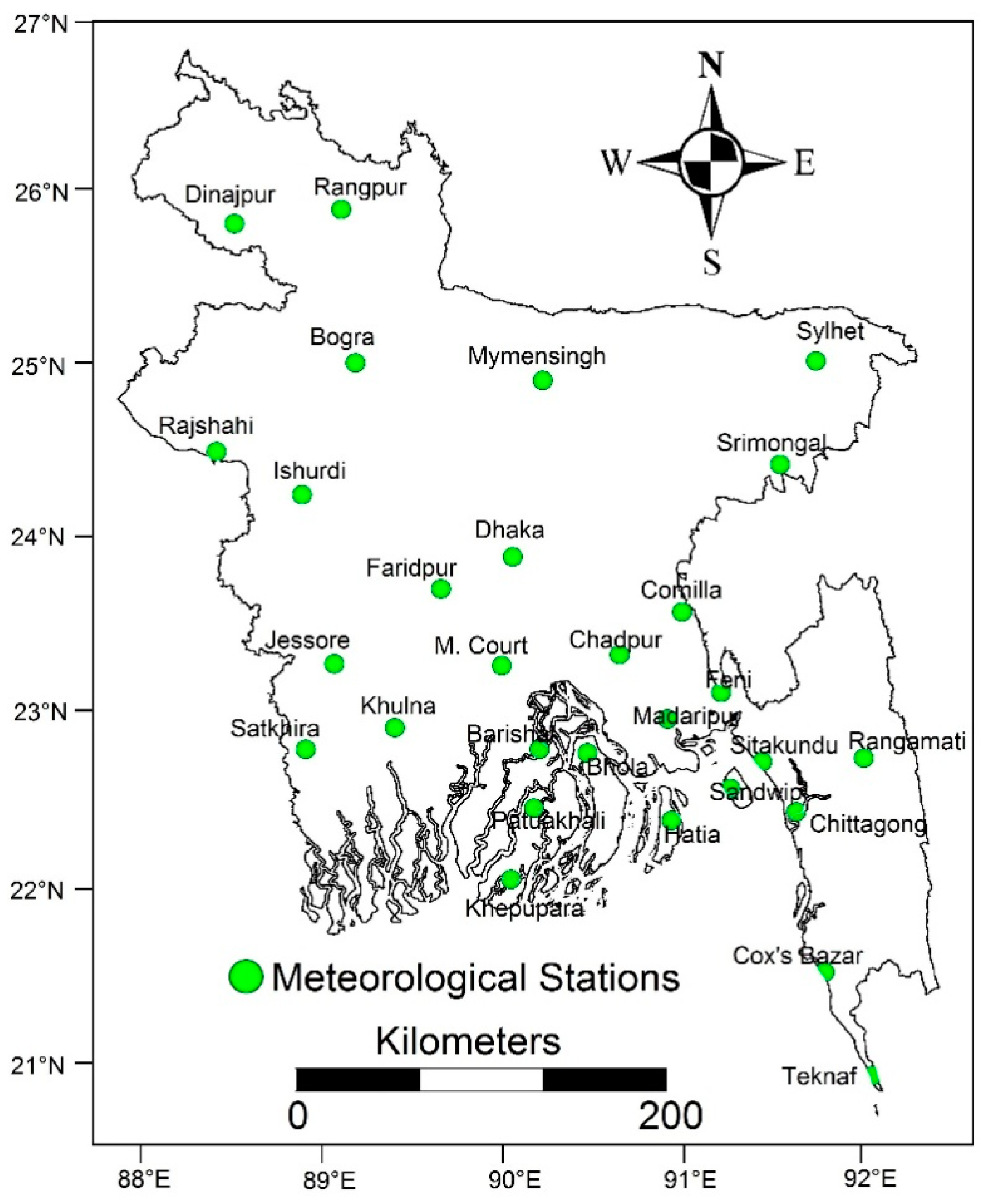
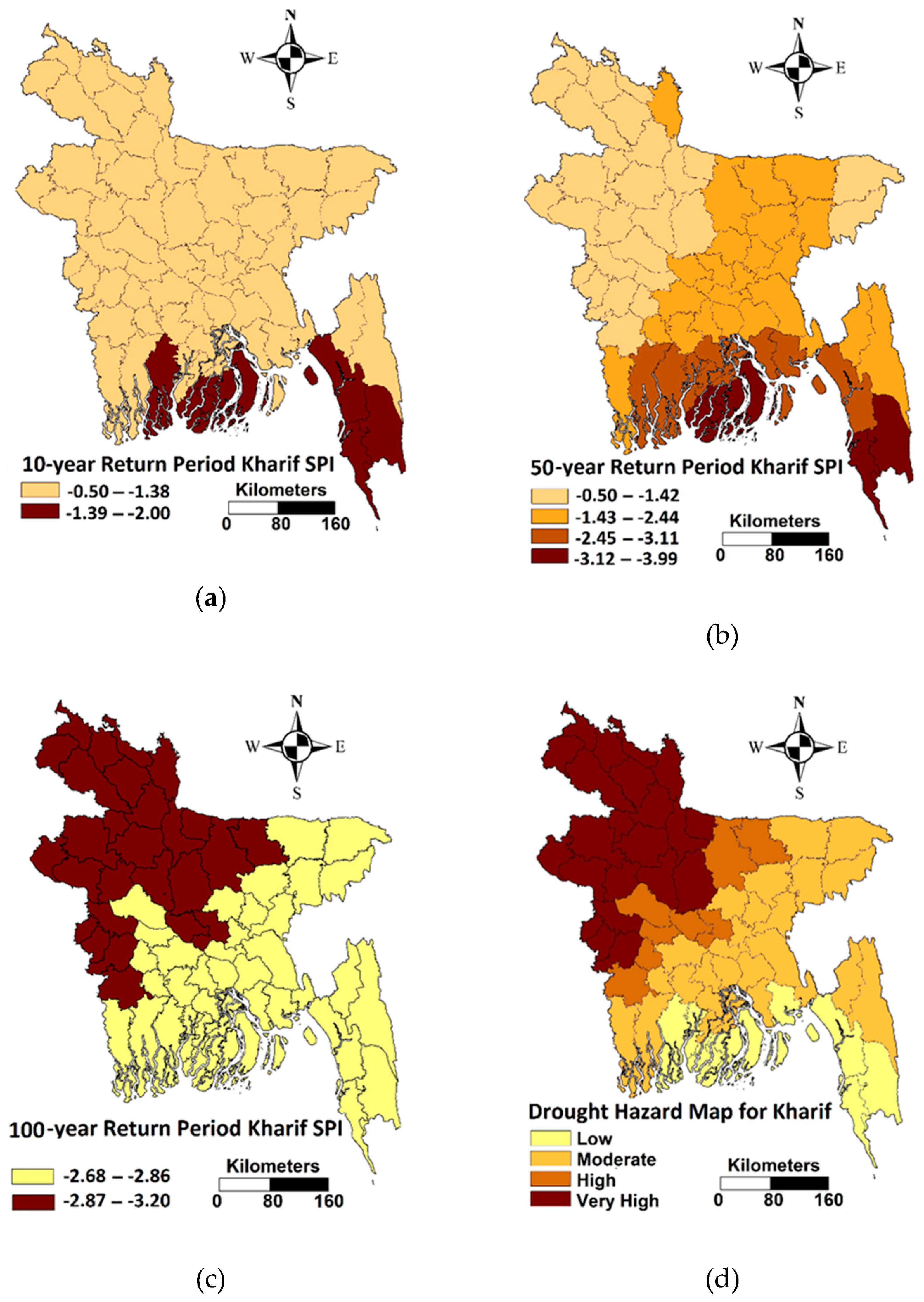
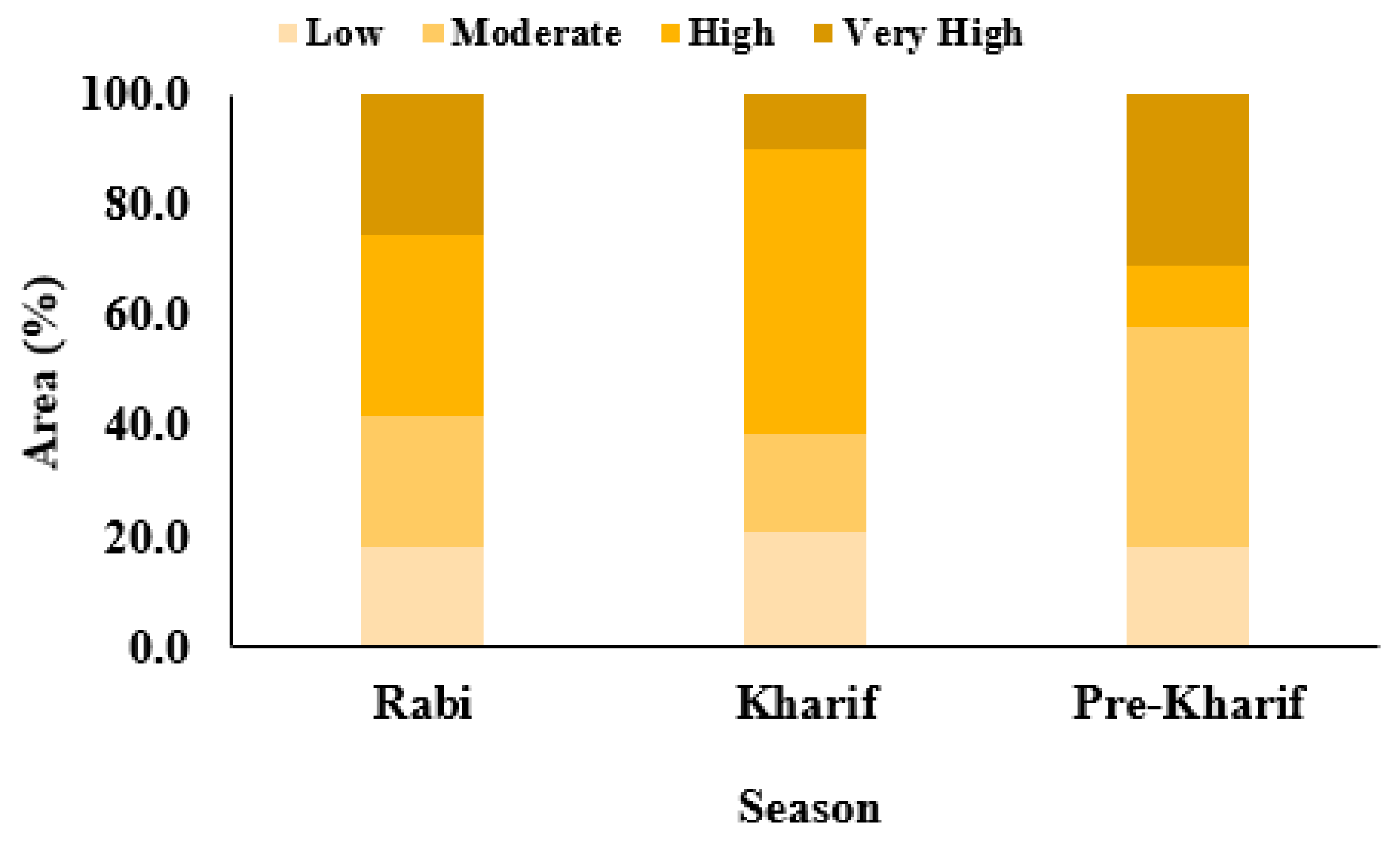
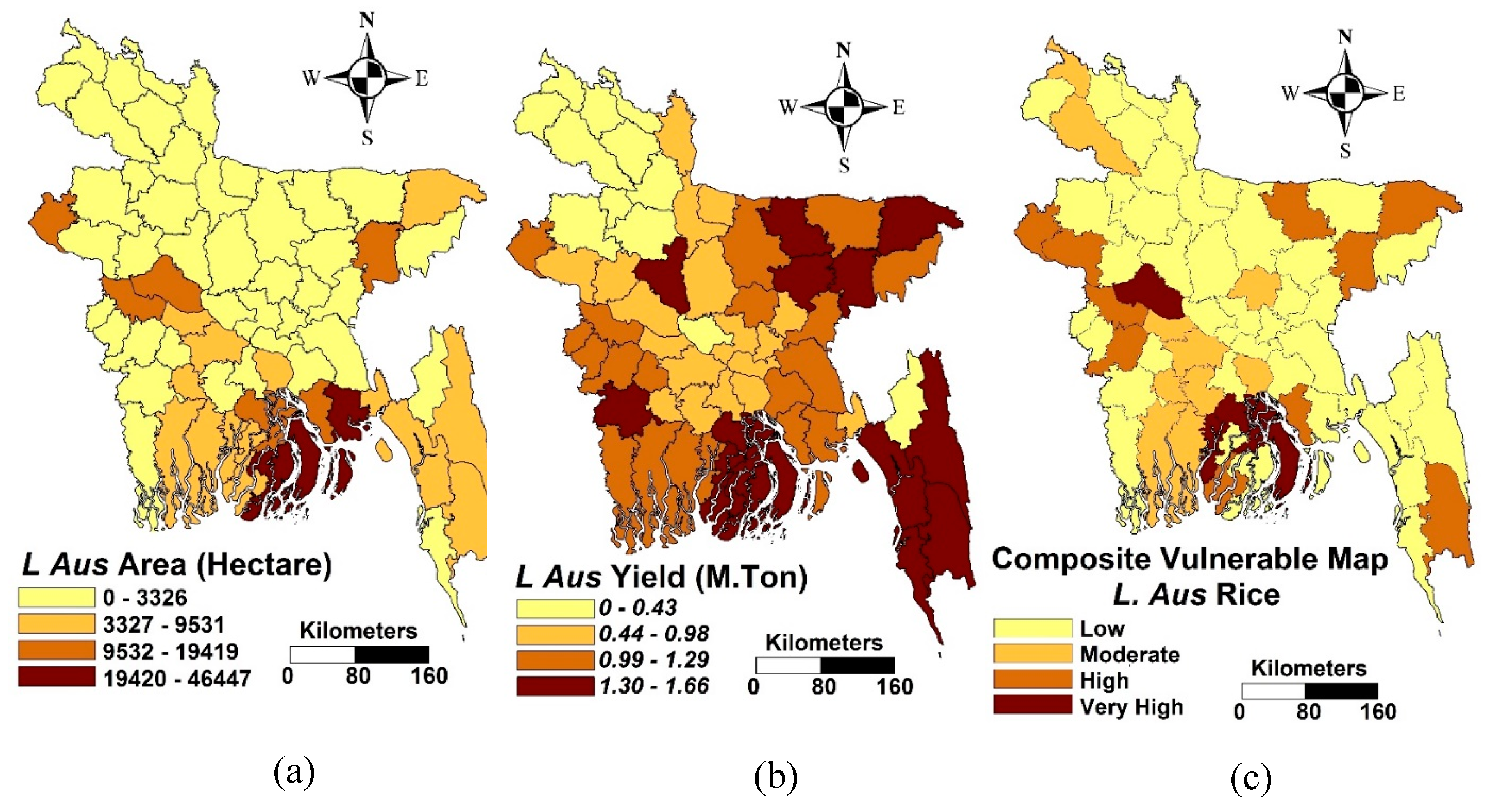
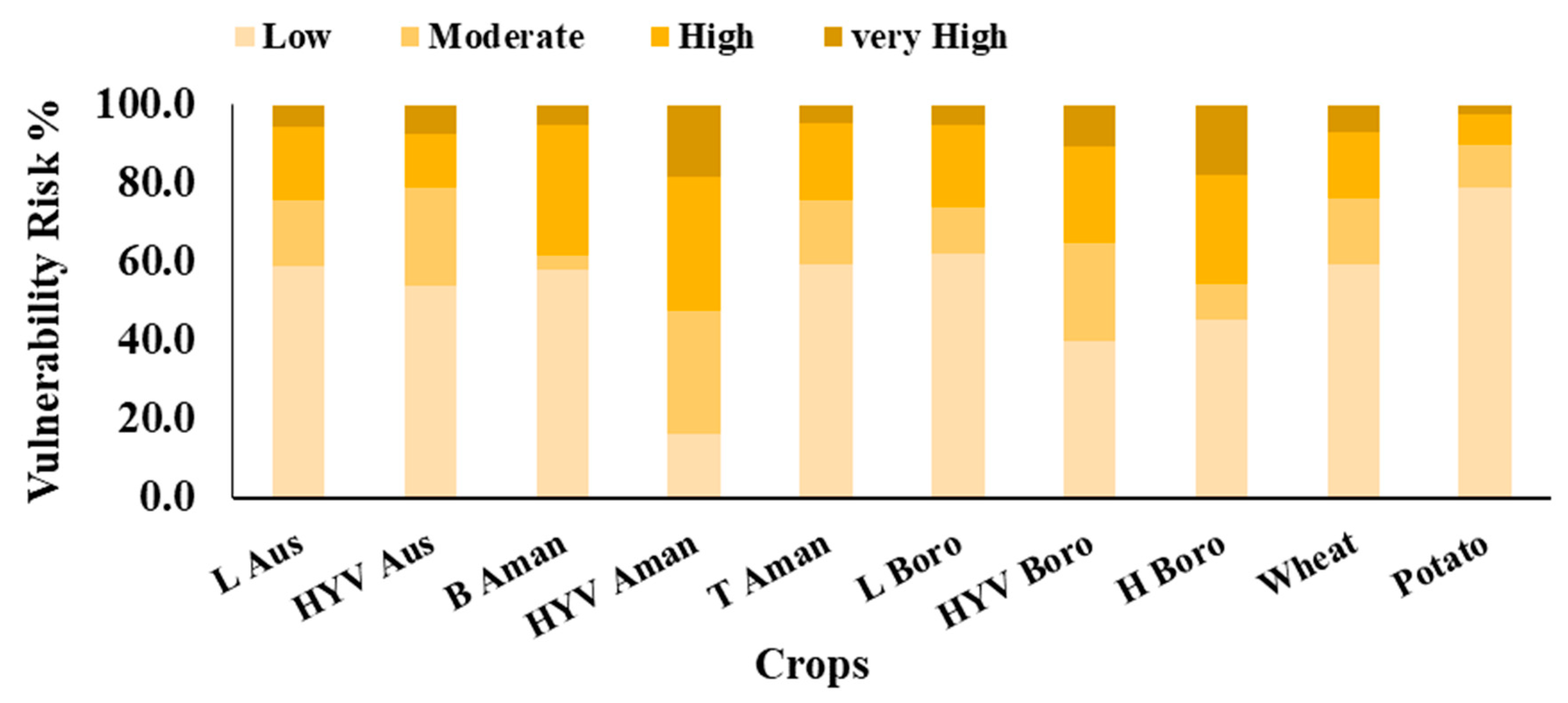
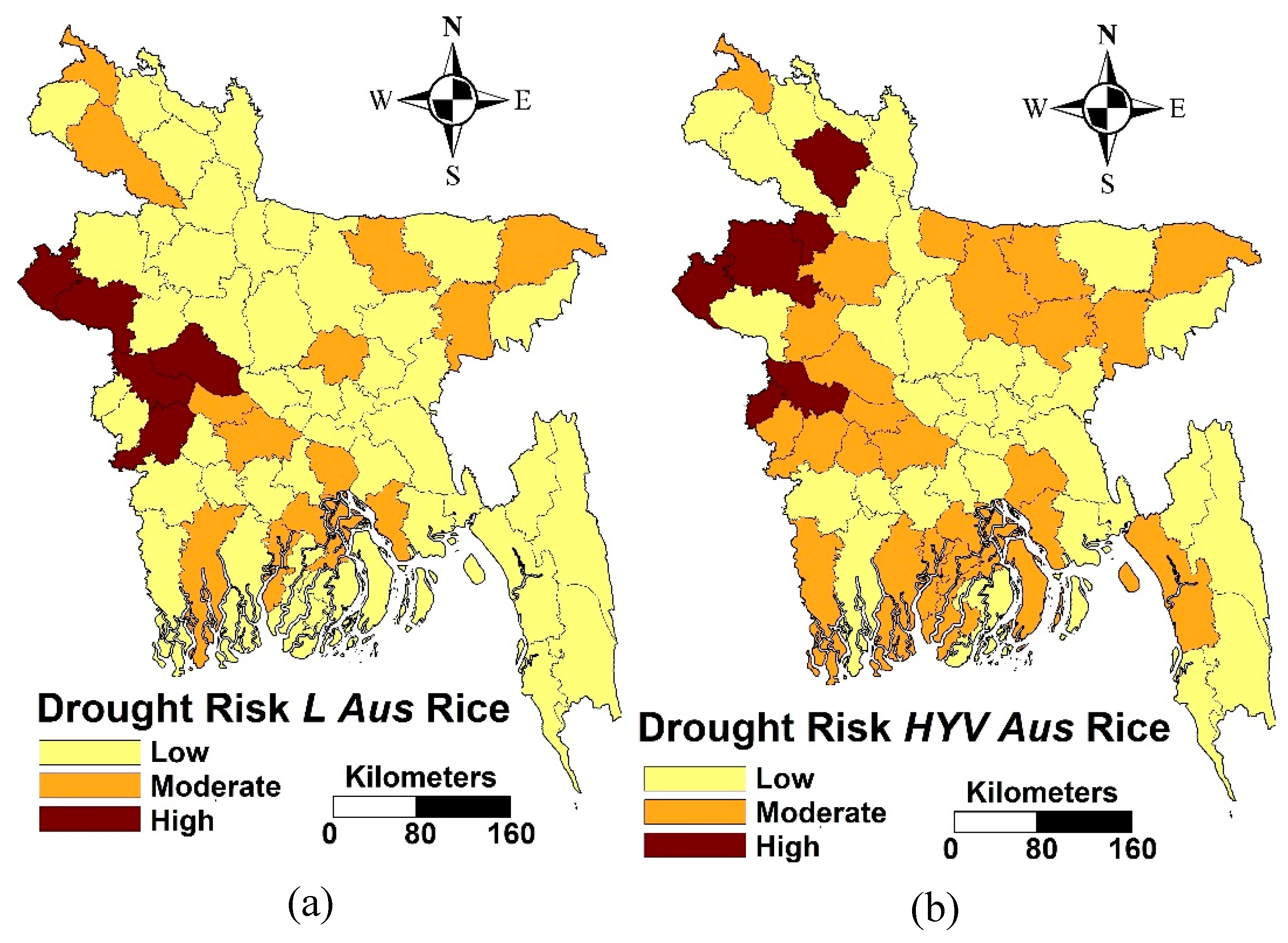
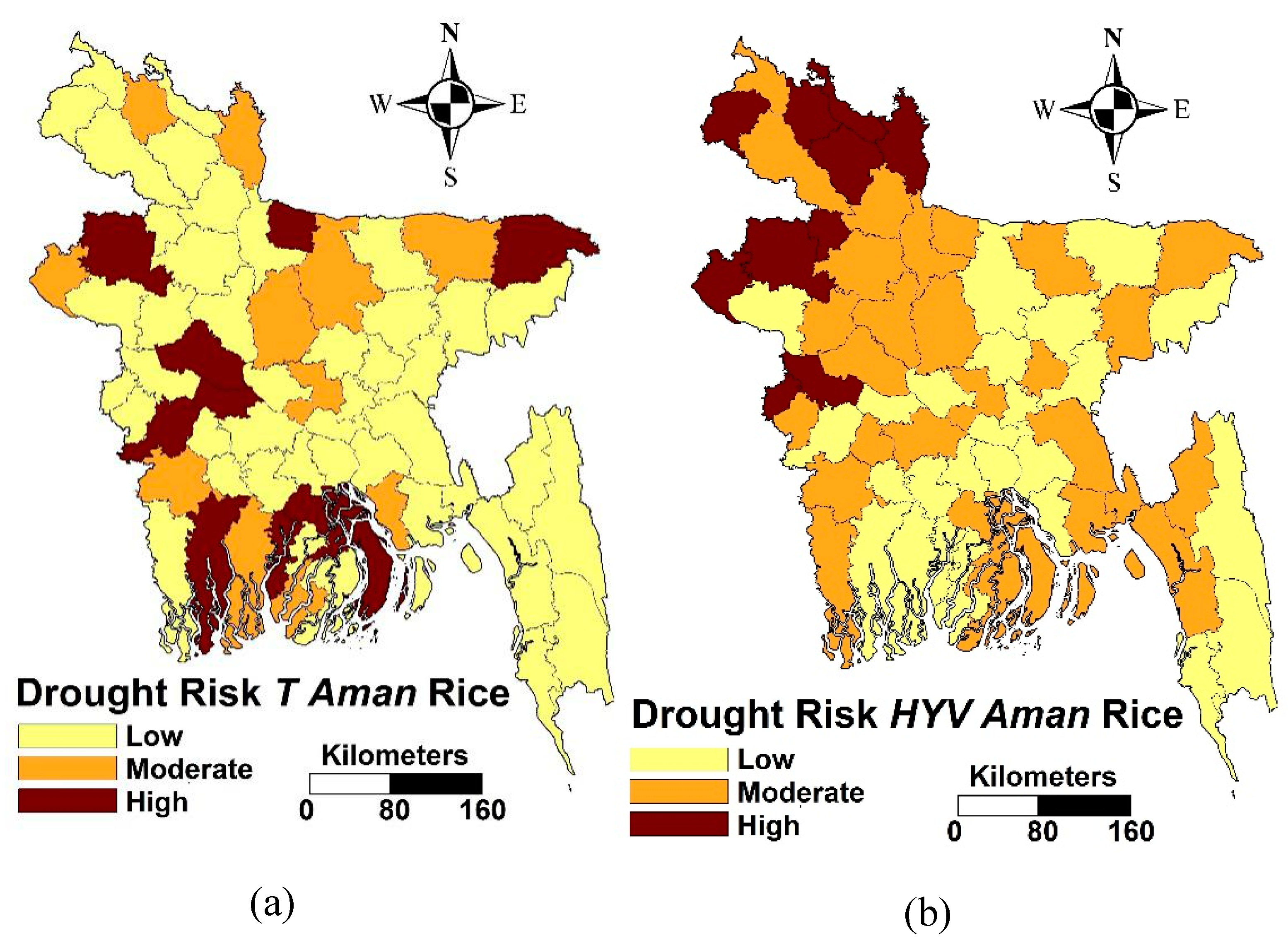
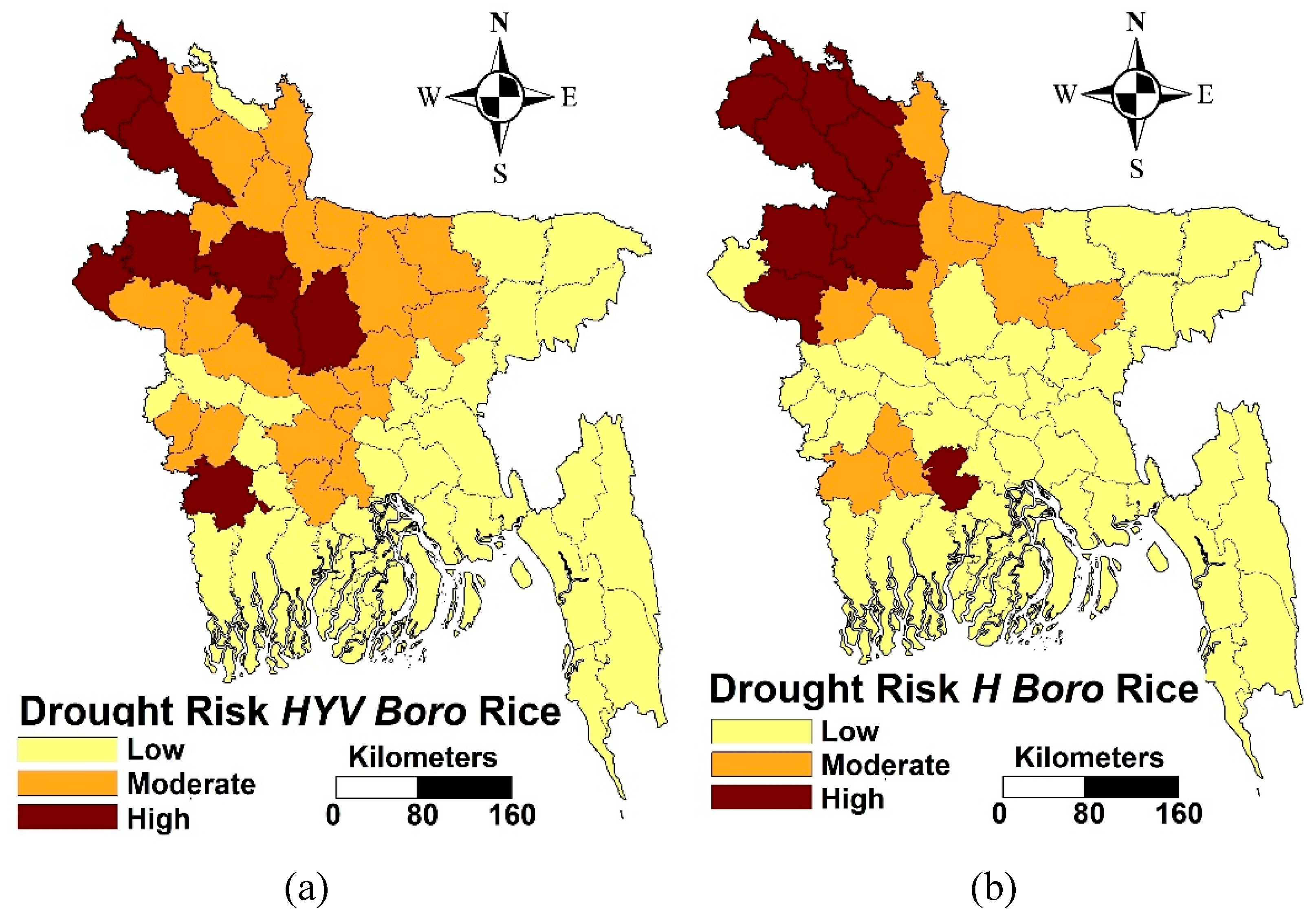
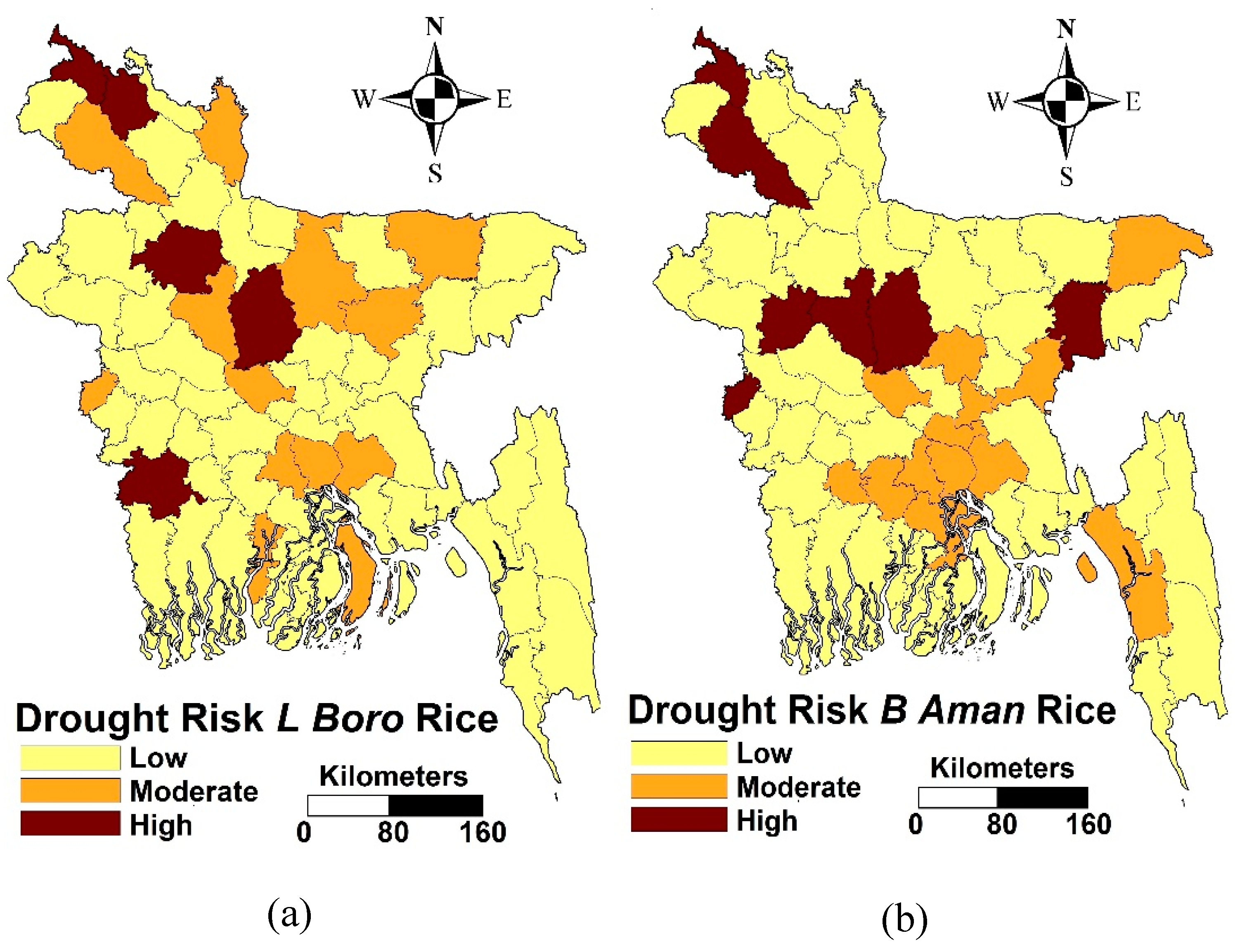
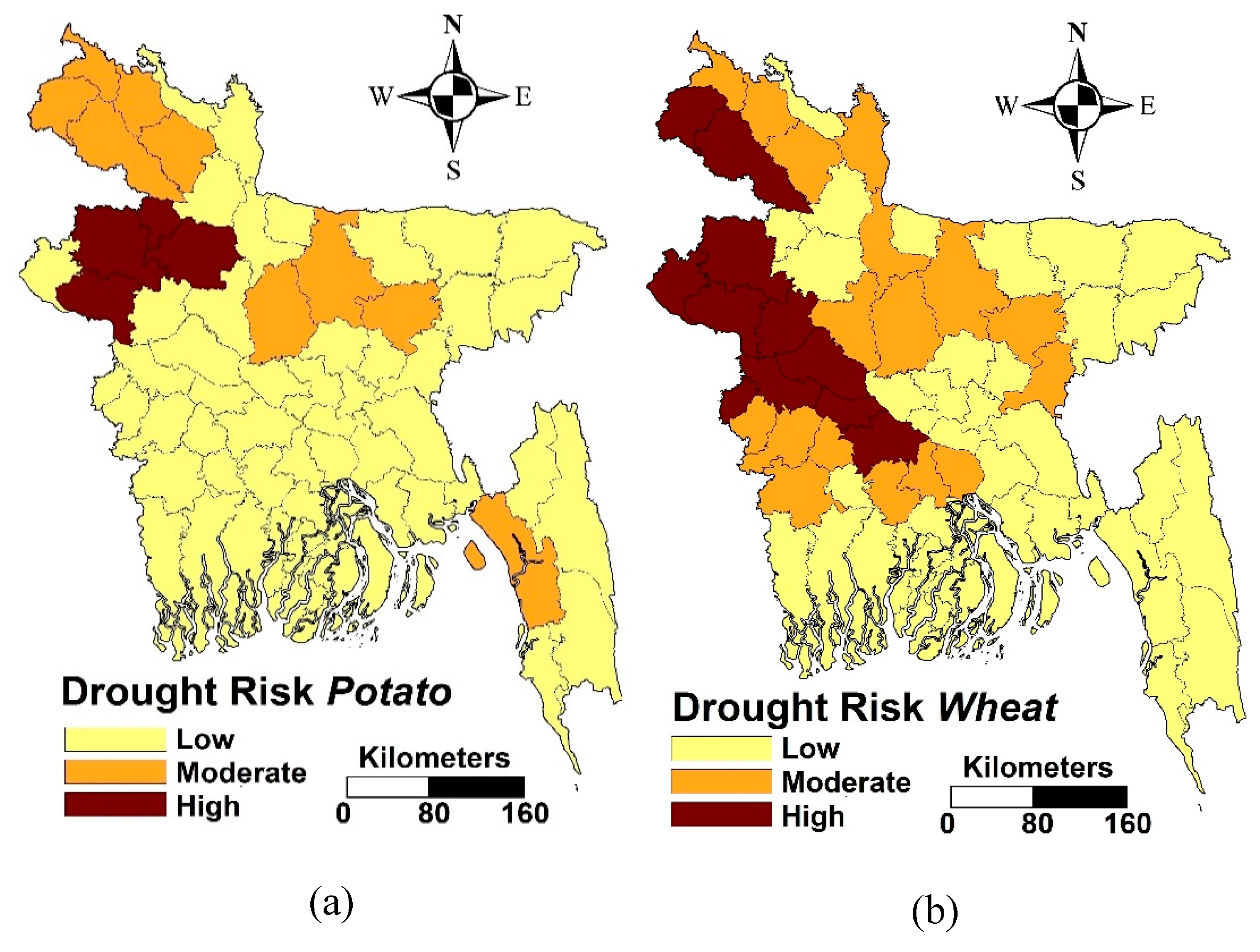
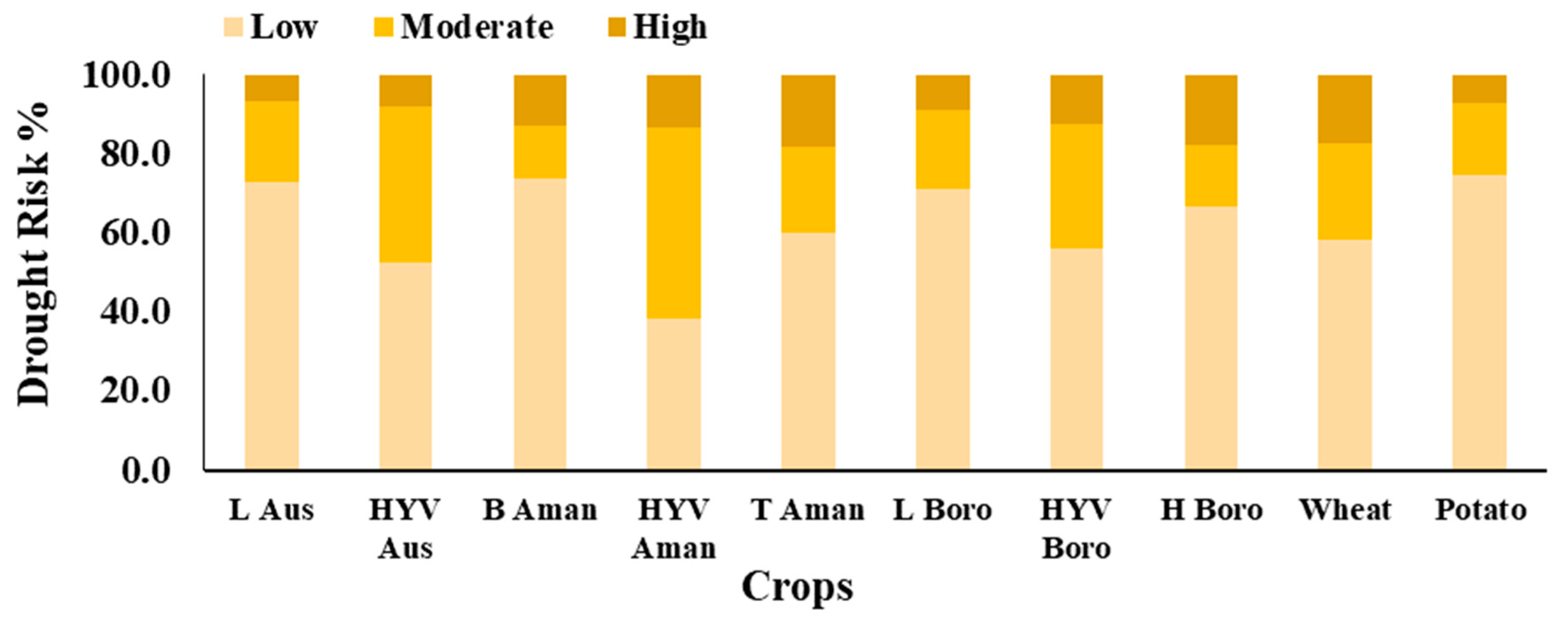
| Crop | Jan | Feb | Mar | Apr | May | Jun | Jul | Aug | Sep | Oct | Nov | Dec | ||||
|---|---|---|---|---|---|---|---|---|---|---|---|---|---|---|---|---|
| L Aus/HYV Aus/B Aman/HYV Aman/T Aman/HYV Boro | ||||||||||||||||
| L Boro/HYV Boro | ||||||||||||||||
| Wheat/Potato | ||||||||||||||||
| Control Variable | State Variable | Model Name | Normalization Formula |
|---|---|---|---|
| 2 | 1 | Cusp | |
| 3 | 1 | Swallowtail | |
| 4 | 1 | Butterfly | |
| 5 | 1 | Wigwam |
| Sub-System | Indicators (SPI) | Mean Value | Rank | Weight |
|---|---|---|---|---|
| Kharif 100-year return period | −2.68 − −2.86 | −2.770 | 0 | 0.5 |
| −2.87 − −3.20 | −3.035 | 1 | ||
| Kharif 50-year return period | −0.50 − −1.42 | −0.960 | 0 | 0.545 |
| −1.43 − −2.44 | −1.935 | 0.376 | ||
| −2.45 − −3.11 | −2.780 | 0.701 | ||
| −3.12 − −3.99 | −3.555 | 1 | ||
| Kharif 10-year return period | −0.50 − −1.38 | −0.940 | 0 | 0.5 |
| −1.39 − −2.00 | −1.695 | 1 |
| Sub-System | Indicators | Mean Value | Rank | Weight |
|---|---|---|---|---|
| Area (L Aus Rice) | 19420−46447 | 32933 | 1 | 0.267 |
| 9532−19419 | 14475 | 0.409 | ||
| 3327−9531 | 6428 | 0.152 | ||
| 0 −3326 | 1663 | 0 | ||
| Yield (L Aus Rice) | 1.30−1.66 | 1.47 | 1 | 0.353 |
| 0.99−1.29 | 1.13 | 0.730 | ||
| 0.44−0.98 | 0.7 | 0.389 | ||
| 0.0−0.43 | 0.21 | 0 |
© 2019 by the authors. Licensee MDPI, Basel, Switzerland. This article is an open access article distributed under the terms and conditions of the Creative Commons Attribution (CC BY) license (http://creativecommons.org/licenses/by/4.0/).
Share and Cite
Alamgir, M.; Mohsenipour, M.; Homsi, R.; Wang, X.; Shahid, S.; Shiru, M.S.; Alias, N.E.; Yuzir, A. Parametric Assessment of Seasonal Drought Risk to Crop Production in Bangladesh. Sustainability 2019, 11, 1442. https://doi.org/10.3390/su11051442
Alamgir M, Mohsenipour M, Homsi R, Wang X, Shahid S, Shiru MS, Alias NE, Yuzir A. Parametric Assessment of Seasonal Drought Risk to Crop Production in Bangladesh. Sustainability. 2019; 11(5):1442. https://doi.org/10.3390/su11051442
Chicago/Turabian StyleAlamgir, Mahiuddin, Morteza Mohsenipour, Rajab Homsi, Xiaojun Wang, Shamsuddin Shahid, Mohammed Sanusi Shiru, Nor Eliza Alias, and Ali Yuzir. 2019. "Parametric Assessment of Seasonal Drought Risk to Crop Production in Bangladesh" Sustainability 11, no. 5: 1442. https://doi.org/10.3390/su11051442
APA StyleAlamgir, M., Mohsenipour, M., Homsi, R., Wang, X., Shahid, S., Shiru, M. S., Alias, N. E., & Yuzir, A. (2019). Parametric Assessment of Seasonal Drought Risk to Crop Production in Bangladesh. Sustainability, 11(5), 1442. https://doi.org/10.3390/su11051442








